Comparative analysis of silage baling materials
Silage is an important feed in animal husbandry, and its baling and storage methods directly affect the quality and cost of the feed. Common silage baling materials are rope, plastic net, and transparent film. Also, there is a forage film for wrapping. The following is a detailed analysis and suggestions on choosing suitable baling materials for the silage baler and wrapper.
Rope: economical and practical
The rope is a traditional silage baling material made from natural grass, which is economical and environmentally friendly. The best feature of yarn is that it can be eaten directly by livestock without worrying about material residues.
One roll of rope can pack 70-85 silage bales, and the bale size is Φ55*52cm.

Plastic net: suitable for fragmented silage
The plastic net is made of high-strength material, which enables quick baling. It’s suitable for baling crumbled or loose silage. Nets provide a tighter bale, reducing the problem of forage falling apart during transportation.
Compared to ropes, one bundle of net can pack 220-280 silage bales, with a size of Φ55*52cm.

Transparent film: the latest technology for silage baling
Transparent films are the new trend in silage bundling, providing additional protection in addition to bundling silage. This film has good sealing properties, which prevents air from entering and ensures the fermentation of the feed, thus improving feed quality.
One roll can bundle about 330 silage bales, with a size of Φ60*52cm.

Forage film: wrapping silage bales after bundling
Forage film is a kind of plastic film material specialized in silage preservation, which has the advantages of good sealing, long preservation time and wide applicability. It is used with Taizy’s automatic silage baling and wrapping machine to wrap silage bales after baling.
It can effectively improve the fermentation quality of silage, reduce feed waste, and improve breeding efficiency. One silage bale is usually wrapped in 2 or 3 layers.

How to choose suitable silage baling materials used for silage baler?
Each of these three(rope, plastic net and transparent film) has advantages and disadvantages for different scenarios and needs. Below are key considerations and recommendations for choosing the right feed-bailing twine.
- Choose according to the feed type
- Rope: ideal for whole feed bales, such as corn stalks or pasture grass. Its rough structure holds large pieces of feed and requires no additional handling.
- Plastic net: suitable for baling crumbled or loose feed, such as crushed silage. The netting is tightly bound and prevents the feed from falling apart during handling.
- Transparent film: best for silage that needs to be kept for a long time. It can seal the feed, reduce the entry of oxygen, promote fermentation and improve feed quality.
- Choose according to budget
- Rope: the lowest cost and economical, suitable for small farms or family farms with limited budget.
- Net: moderately priced and more efficient, suitable for medium-sized farms and users with certain quality requirements for feed.
- Transparent film: the most costly but the most effective, suitable for large-scale farms or commercial farms pursuing high-quality feed.
- Selection according to silage baling equipment
- Rope: Model 50 uses this most frequently.
- Plastic net: Model 50 and Model 70 both can use nets for silage bundling.
- Transplant film: Model 60 uses it commonly.
- Choose according to environmental needs
- Rope: natural and environmentally friendly, can be eaten directly by livestock, no waste.
- Netting: cannot be eaten directly, but can be recycled.
- Transparent film: has the best sealing effect, but waste needs to be properly handled to reduce the impact on the environment.


